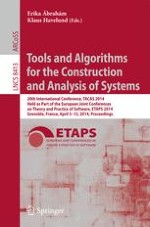This book constitutes the proceedings of the 20th International Conference on Tools and Algorithms for the Construction and Analysis of Systems, TACAS 2014, which took place in Grenoble, France, in April 2014, as part of the European Joint Conferences on Theory and Practice of Software, ETAPS 2014. The total of 42 papers included in this volume, consisting of 26 research papers, 3 case study papers, 6 regular tool papers and 7 tool demonstrations papers, were carefully reviewed and selected from 161 submissions. In addition the book contains one invited contribution. The papers are organized in topical sections named: decision procedures and their application in analysis; complexity and termination analysis; modeling and model checking discrete systems; timed and hybrid systems; monitoring, fault detection and identification; competition on software verification; specifying and checking linear time properties; synthesis and learning; quantum and probabilistic systems; as well as tool demonstrations and case studies.
